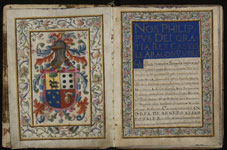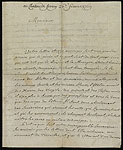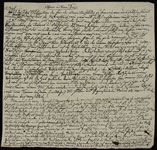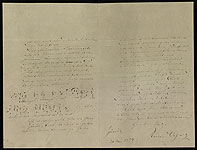Modern Times
 The Reformation put an end to the Middle Ages and begins the early Modern Time (the term adopted by modern historical science). Protestantism rejected the Holy Tradition (including the works of the Church Fathers), and recognized only the authority of the Holy Scripture - the Bible, all of whose books have been translated into German by the doctor of theology, the former Augustinian monk Martin Luther (1483-1546). Luther's central doctrine was "justification by grace through faith alone". The principle of justification by faith alone means that man's deliverance from sins is achieved solely through personal faith in the redemptive sacrifice of Christ, without the mediation of the Church. Plain worship services, without magnificent rituals, were conducted in Protestant churches in the national languages. The Protestant Evangelical Church got rid of the huge Catholic hierarchy and has developed a simple and clear structure. This is evident from a document, dated to 3 August 1544, kept in the National Library of Russia The main ideologists of Protestantism Martin Luther, his closest friend and associate Philip Melanchthon (1497-1560) and Johannes Bugenhagen (1485-1558) signed a document on the appointment of the doctor of theology Theodor Fabricius(1501-1571) the superintendent (head) of the Evangelical Church in Zerbst.
The Reformation put an end to the Middle Ages and begins the early Modern Time (the term adopted by modern historical science). Protestantism rejected the Holy Tradition (including the works of the Church Fathers), and recognized only the authority of the Holy Scripture - the Bible, all of whose books have been translated into German by the doctor of theology, the former Augustinian monk Martin Luther (1483-1546). Luther's central doctrine was "justification by grace through faith alone". The principle of justification by faith alone means that man's deliverance from sins is achieved solely through personal faith in the redemptive sacrifice of Christ, without the mediation of the Church. Plain worship services, without magnificent rituals, were conducted in Protestant churches in the national languages. The Protestant Evangelical Church got rid of the huge Catholic hierarchy and has developed a simple and clear structure. This is evident from a document, dated to 3 August 1544, kept in the National Library of Russia The main ideologists of Protestantism Martin Luther, his closest friend and associate Philip Melanchthon (1497-1560) and Johannes Bugenhagen (1485-1558) signed a document on the appointment of the doctor of theology Theodor Fabricius(1501-1571) the superintendent (head) of the Evangelical Church in Zerbst.
 Protestantism, in various versions, was spreading rapidly across Europe. In Switzerland, the Netherlands and in France it took the form of Calvinism. French Protestants are known as Huguenots (French Huguenots, from German Eidgenossen - Allies). The struggle between Catholics and Protestants in France resulted in the prolonged Wars of Religion lasted from 1562 to 1598. These series of conflicts threatened to destroy the unity of the kingdom. The most famous event is the Massacre of St. Bartholomew's Day which took place on 24 August 1572, when about 40 thousand Huguenots were killed. Three months later, on 3 December 1572, the French king Charles IX (1550-1574) signed the Order to the Paris Chamber of Accounts to allocate funds of 100,000 livres for sending the army against the stronghold of the Huguenots, the city of La Rochelle.
Protestantism, in various versions, was spreading rapidly across Europe. In Switzerland, the Netherlands and in France it took the form of Calvinism. French Protestants are known as Huguenots (French Huguenots, from German Eidgenossen - Allies). The struggle between Catholics and Protestants in France resulted in the prolonged Wars of Religion lasted from 1562 to 1598. These series of conflicts threatened to destroy the unity of the kingdom. The most famous event is the Massacre of St. Bartholomew's Day which took place on 24 August 1572, when about 40 thousand Huguenots were killed. Three months later, on 3 December 1572, the French king Charles IX (1550-1574) signed the Order to the Paris Chamber of Accounts to allocate funds of 100,000 livres for sending the army against the stronghold of the Huguenots, the city of La Rochelle.
 The French Wars of Religion lasted more than 30 years and ended in 1598 with the Edict of Nantes. The edict granted the Protestants of France freedom of conscience and reserved the sea port of La Rochelle for them. However, after the revolt of the Huguenots in 1625, the first minister of King Louis XIII Cardinal Richelieu (Armand- Jean du Plessis, duc de Richelieu, 1585-1642) announced the suppression of the Huguenot rebellions as the main priority of the kingdom. In September 1627, he began the siege of La Rochelle, which ended in the unconditional surrender of the city on 28 October 1628. During the siege of the fortress, the Cardinal de Richelieu was inseparable with the army. In a letter to the French ambassador in Turkey, Philippe de Harlay Count de Cézy, Richelieu mentioned, not without some pride, that the taking of La Rochelle and his role in the event gained recognition throughout Europe up to the Muslim World:
The French Wars of Religion lasted more than 30 years and ended in 1598 with the Edict of Nantes. The edict granted the Protestants of France freedom of conscience and reserved the sea port of La Rochelle for them. However, after the revolt of the Huguenots in 1625, the first minister of King Louis XIII Cardinal Richelieu (Armand- Jean du Plessis, duc de Richelieu, 1585-1642) announced the suppression of the Huguenot rebellions as the main priority of the kingdom. In September 1627, he began the siege of La Rochelle, which ended in the unconditional surrender of the city on 28 October 1628. During the siege of the fortress, the Cardinal de Richelieu was inseparable with the army. In a letter to the French ambassador in Turkey, Philippe de Harlay Count de Cézy, Richelieu mentioned, not without some pride, that the taking of La Rochelle and his role in the event gained recognition throughout Europe up to the Muslim World:
"Monsieur, sending to you my gratitude for your letter about the capture of La Rochelle which I received from you, I could feel yourself vain, <...> when I saw that my name was known even in the place where you were.."
 At the end of 16th century, Spain was at the height of power. King Philip II of Spain (1527-1598) ruled over large areas in the Old World (Spai (North and South America). A huge role in gaining and maintaining these lands belonged to the Spanish nobility. The exhibition fitures a royal charter.
At the end of 16th century, Spain was at the height of power. King Philip II of Spain (1527-1598) ruled over large areas in the Old World (Spai (North and South America). A huge role in gaining and maintaining these lands belonged to the Spanish nobility. The exhibition fitures a royal charter.
A Spanish charter was designed as a parchment codex. Its first page was adorned with a noble coat of arms in a colorful ornamental frame, a floral border often framed the initial page of the document. The peculiarity of the charters issued by Spanish kings was a signature. A king never put his name on the documents, he simply wrote: "Yo el rey" ( "I am the King"). Philip II grants to Andres de Arnedo Rosales and his descendants an estate and a village with all peasants, bound to these plots of land, and with all land ownership rights. In the middle of the document is the text of Emperor Rudolf II's letters patent, dated to 1577, on awarding the rank of imperial captain to Arnedo Rosales, with a salary of 50 gold marks.
 In the mid 17th century, after a bourgeois revolution, England was on the way towards a constitutional monarchy. On 30 January 1649, King Charles I was executed, his political opponent Oliver Cromwell (1599-1658) became Lord Protector, but, in fact, a military dictator. A kind of evidence of these historical events was a handwritten manuscript of the 15th century, that paraphrased Guido delle Colonne's history of the destruction of Troy. In the book, three British monarch left their possessory records:
In the mid 17th century, after a bourgeois revolution, England was on the way towards a constitutional monarchy. On 30 January 1649, King Charles I was executed, his political opponent Oliver Cromwell (1599-1658) became Lord Protector, but, in fact, a military dictator. A kind of evidence of these historical events was a handwritten manuscript of the 15th century, that paraphrased Guido delle Colonne's history of the destruction of Troy. In the book, three British monarch left their possessory records:
Richard III Plantagenet (1452-1485) wrote 'Ricardus rex' on the first folio;
James I Stuart (1566-1725) signed his autograph, 'James R.' on the last folio of the codex;
;
Charles I Stuart (1600-1649) inscribe"Cad rolus R." - also on the last folio.
The first folio carries a half-erased name of another owner, 'O. Cromvel 1656', above the possessory record of Richard III. While King Charles I signed the last folio, the Oliver Cromwell wrote his name on the first sheet of the manuscript. So the book from the library of the executed king of England passed into the hands of Lord Protector Oliver Cromwell.
 During the reign of Louis XIV(1638-1715) whom his contemporaries called the Sun King, the absolute power of the king in France reached its peak. Louis XIV said, 'I am the State' and delved into all major and minor affairs of state. The exhibition features the order of 22 June 1657 to the commander of a cavalry corps de Gouvernet to enlist the noblemen de la Coste and Richard de la Rousselier in a detachment of light cavalry.
During the reign of Louis XIV(1638-1715) whom his contemporaries called the Sun King, the absolute power of the king in France reached its peak. Louis XIV said, 'I am the State' and delved into all major and minor affairs of state. The exhibition features the order of 22 June 1657 to the commander of a cavalry corps de Gouvernet to enlist the noblemen de la Coste and Richard de la Rousselier in a detachment of light cavalry.
 The philosopher, educator, poet, satirist, historian and writer Voltaire (François Marie Arouet de Voltaire, 1694-1778) was born during the life of Louis XIV in 1694. Numerous researches investigate a question of relations of Voltaire with Russia. Well studied is his extensive correspondence with Russian addressees, especially with Empress Catherine II and other high-ranking persons. Voltaire also corresponded with Russian authors. In a letter to the poet, writer and playwright Alexander Sumarokov (1717-1777) on 26 February 1769, Voltaire answers questions of Sumarokov and commends works of the addressee.
The philosopher, educator, poet, satirist, historian and writer Voltaire (François Marie Arouet de Voltaire, 1694-1778) was born during the life of Louis XIV in 1694. Numerous researches investigate a question of relations of Voltaire with Russia. Well studied is his extensive correspondence with Russian addressees, especially with Empress Catherine II and other high-ranking persons. Voltaire also corresponded with Russian authors. In a letter to the poet, writer and playwright Alexander Sumarokov (1717-1777) on 26 February 1769, Voltaire answers questions of Sumarokov and commends works of the addressee.
 In Germany, the period from the late 1760s to the early 1780s was marked by literary movement "Sturm und Drang" ( also called "Storm and Stress"). Researchers have different opinions on the place of this phenomenonon in the history of culture. Some scientists consider it to be a harbinger of sentimentalism and romanticism, the other see it as a further development of the ideas of the Enlightenment. The exhibition shows a note written by Johann Wolfgang von Goethe(1749-1832) to his closest friends, the Herder family: the theoretician of "Sturm und Drang" Johann Gottfried Herder, (1744-1803) and his wife Maria Karolina (1750-1809). Goethe executes Herder's request - the poet sends him some poems, with a note that he expects also to be welcomed warmly in their home.
In Germany, the period from the late 1760s to the early 1780s was marked by literary movement "Sturm und Drang" ( also called "Storm and Stress"). Researchers have different opinions on the place of this phenomenonon in the history of culture. Some scientists consider it to be a harbinger of sentimentalism and romanticism, the other see it as a further development of the ideas of the Enlightenment. The exhibition shows a note written by Johann Wolfgang von Goethe(1749-1832) to his closest friends, the Herder family: the theoretician of "Sturm und Drang" Johann Gottfried Herder, (1744-1803) and his wife Maria Karolina (1750-1809). Goethe executes Herder's request - the poet sends him some poems, with a note that he expects also to be welcomed warmly in their home.
On 14 July, France celebrate its national holiday - the Day of the Storming of the Bastille by the rebelled people in 1789. In the 18th century, the fortress-prison Bastille became a symbol of the lawlessness of royal power. An unwanted person was imprisoned in the Bastille by a lettre de cachet - a special letter of the king. The lettre contained an order directly from the king to arrest an individual without a trial. The king signed the document and left a blank space to be filled in with any name.
 Part of Bastille archive documents are kept in the National Library of Russia. The exhibition presents the order of King Louis XV (lettre de cachet) to Commandant of the Bastille Bernard René Jourdan, marquis de Launay, 'Monsieur de Launay, I am sending this letter to you to order you to put La Mairir in my castle of Bastille, and keep him there until my new order. Whereupon I pray God to keep you, Mr De Launay, under his holy right hand. Given at Antwerp on 4 June 1746'. The king's signature was affixed by a secretary of state, then the document was confirmed by War Minister d'Argenson (Marc-Pierre de Voyer de Paulmy, Count d'Argenson, 1696 - 1764).
Part of Bastille archive documents are kept in the National Library of Russia. The exhibition presents the order of King Louis XV (lettre de cachet) to Commandant of the Bastille Bernard René Jourdan, marquis de Launay, 'Monsieur de Launay, I am sending this letter to you to order you to put La Mairir in my castle of Bastille, and keep him there until my new order. Whereupon I pray God to keep you, Mr De Launay, under his holy right hand. Given at Antwerp on 4 June 1746'. The king's signature was affixed by a secretary of state, then the document was confirmed by War Minister d'Argenson (Marc-Pierre de Voyer de Paulmy, Count d'Argenson, 1696 - 1764).
La Mairir was imprisoned in the Bastille for spying. He was released on 10 October 1746.
 The French Revolution changed the face of not only France but also the whole of Europe. In many ways, activities of the Enlighteners - Encyclopedists contributed to it. The motto of the revolution were "Liberty, equality and fraternity" of every man or woman, regardless of a social class. A participant of multiple events of this period of French history was the younger brother of Maximilien Robespierre, Augustin Robespierre (1763-1794). The exhibition demonstrates a receipt of the treasurer of the revolutionary army in Italy, dated to 30 October 1793, which was affixed by Augustin Robespierre and sealed with his personal seal.
The French Revolution changed the face of not only France but also the whole of Europe. In many ways, activities of the Enlighteners - Encyclopedists contributed to it. The motto of the revolution were "Liberty, equality and fraternity" of every man or woman, regardless of a social class. A participant of multiple events of this period of French history was the younger brother of Maximilien Robespierre, Augustin Robespierre (1763-1794). The exhibition demonstrates a receipt of the treasurer of the revolutionary army in Italy, dated to 30 October 1793, which was affixed by Augustin Robespierre and sealed with his personal seal.
 At the request of Augustin Robespierre, in January 1794, the young captain Napoleon Bonaparte (1769-1821) was promoted to the position of Brigadier General for the successful action in the battle of Toulon. The NLR keeps the letter of Emperor of the French Napoleon I, dated to 29 June 1808, addressed to the Chief of Napoleon's Staff Marshal Louis-Alexandre Berthier (prince de Neuchâtel et Valangin, prince de Wagram, 1753-1815). In the letter, the Emperor briefly informs Berthier about places he visited during his inspection tour of Italy.
At the request of Augustin Robespierre, in January 1794, the young captain Napoleon Bonaparte (1769-1821) was promoted to the position of Brigadier General for the successful action in the battle of Toulon. The NLR keeps the letter of Emperor of the French Napoleon I, dated to 29 June 1808, addressed to the Chief of Napoleon's Staff Marshal Louis-Alexandre Berthier (prince de Neuchâtel et Valangin, prince de Wagram, 1753-1815). In the letter, the Emperor briefly informs Berthier about places he visited during his inspection tour of Italy.
 The diplomat P. Waxell (1844-1918), a musicologist and collector of manuscripts, stored a postcard with a reproduction of a portrait of Napoleon I and his autograph in a folder with the letter of the Emperor. The card gives an occasion to remember the interest of the general public in the second half of the 19th century to a handwritten monuments that can tell a lot about past times and past people. Against the background of prevailing media - printed books, newspapers, leaflets - there was a need to see the lines, personally inscribed by the great people. Open postal letters met this need. One side of them was intended for writing the address and the message, and the other side showed, instead of the views of cities or genre scenes, celebrity autographs.
The diplomat P. Waxell (1844-1918), a musicologist and collector of manuscripts, stored a postcard with a reproduction of a portrait of Napoleon I and his autograph in a folder with the letter of the Emperor. The card gives an occasion to remember the interest of the general public in the second half of the 19th century to a handwritten monuments that can tell a lot about past times and past people. Against the background of prevailing media - printed books, newspapers, leaflets - there was a need to see the lines, personally inscribed by the great people. Open postal letters met this need. One side of them was intended for writing the address and the message, and the other side showed, instead of the views of cities or genre scenes, celebrity autographs.
 One of the greatest minds of all time, the philosopher Immanuel Kant (1724-1804) wrote that 'an education is the courage to use your own understanding'. Worthy of note are two small autograph made by Kant. One is an essey "On Inner Sense". The conception of an intuition (innere Sinn) as one of the basic human faculties occupies an important place in the philosophy of Immanuel Kant.
One of the greatest minds of all time, the philosopher Immanuel Kant (1724-1804) wrote that 'an education is the courage to use your own understanding'. Worthy of note are two small autograph made by Kant. One is an essey "On Inner Sense". The conception of an intuition (innere Sinn) as one of the basic human faculties occupies an important place in the philosophy of Immanuel Kant.
 In the eyes of the society of the second half of the 19th century, lines written by hand of a great man were of much value, even if they were inscribed just on a tiny piece of paper. On the back side of a postmarked letter, Kant wrote some logical-mathematical arguments. Beneath them, the other hand made a postscript in Latin, 'scripsit Kant' ( "Kant wrote").
In the eyes of the society of the second half of the 19th century, lines written by hand of a great man were of much value, even if they were inscribed just on a tiny piece of paper. On the back side of a postmarked letter, Kant wrote some logical-mathematical arguments. Beneath them, the other hand made a postscript in Latin, 'scripsit Kant' ( "Kant wrote").
 The reformer of the opera theatre, composer and music theorist Richard Wagner (1813-1883) was in correspondence with the Russian diplomat Prince Evgeny Wittgenstein(1825-1886). In a letter to E. Wittgenstein, dated to 30 May 1854, Wagner cites two lines from the opera The Rhinegold ("Das Rheingold"), on which he was working at the time, and the first performance of which took place just 15 years later in 1869. Wagner invites Prince E. Wittgenstein to him in Zurich and promises to provide an opportunity for a more complete picture of his new opera.
The reformer of the opera theatre, composer and music theorist Richard Wagner (1813-1883) was in correspondence with the Russian diplomat Prince Evgeny Wittgenstein(1825-1886). In a letter to E. Wittgenstein, dated to 30 May 1854, Wagner cites two lines from the opera The Rhinegold ("Das Rheingold"), on which he was working at the time, and the first performance of which took place just 15 years later in 1869. Wagner invites Prince E. Wittgenstein to him in Zurich and promises to provide an opportunity for a more complete picture of his new opera.
 After Emperor Napoleon III seized power, the greatest poet of France, novelist and dramatist Victor Hugo (1802-1885) went into voluntary exile abroad, first to Belgium (1851), then to the islands of Jersey and Guernsey where he spent almost two decades. In exile, Hugo continued to work and publish his writings. The Manuscripts Department of the NLR housed the first edition of his poetry collection "The Legend of Centuries". The book contains pasted-in 35 letters, dated from 1854 to 1859, from Hugo to the proofreader of the edition Noel Parfait (1813-1896). These letters demonstrate Hugo's professional awareness of all the details of book design. As a literary artist, Hugo believed that all nuances of a typographical style are important for a correct perception of the poetic text, including point size, arrengement and number of lines per page, and much more.
After Emperor Napoleon III seized power, the greatest poet of France, novelist and dramatist Victor Hugo (1802-1885) went into voluntary exile abroad, first to Belgium (1851), then to the islands of Jersey and Guernsey where he spent almost two decades. In exile, Hugo continued to work and publish his writings. The Manuscripts Department of the NLR housed the first edition of his poetry collection "The Legend of Centuries". The book contains pasted-in 35 letters, dated from 1854 to 1859, from Hugo to the proofreader of the edition Noel Parfait (1813-1896). These letters demonstrate Hugo's professional awareness of all the details of book design. As a literary artist, Hugo believed that all nuances of a typographical style are important for a correct perception of the poetic text, including point size, arrengement and number of lines per page, and much more.
